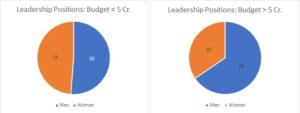Realities of women leadership in civil society organisations

Dr Annapoorna Ravichander & Khushi Shetty
The WHO defines civil society as a “space for collective action around shared interests, purposes and values, generally distinct from government and commercial for-profit actors”. These non-profit Civil Society Organisations (CSOs), or non-government organisations (NGOs), work for the development and welfare of people at local, national and international levels.
In such a space, those who lead the CSOs shape the CSOs. They shape the way welfare opportunities are created and disseminated, the outreach their programmes have and the level of impact that they create on the lives they touch.
In India, the corporate sector has abysmal rates of women leadership, with only 4% of senior management positions being held by women, according to a 2018 study. In Karnataka, of the 75 members of the Legislative Council, only three are women. Women can be seen as categorically underrepresented in each sector. This begs the question, what sort of trends would one see in CSOs?
Women leaders in CSOs
A cross-country survey conducted by Dasra, a philanthropy organisation, reveals that of 328 non-profits, a similar trend of a gender gap in leadership is prevalent. In organisations with a budget of less than Rs 5 crore, the number of men and women in leadership positions remains similar with 20% and 19%, respectively. The gap comes in with an increase in budget, wherein 38% of organisations are now led by men and only 20% by women. This has been visualised below.
 Another disparity that cropped up from the survey was that 13 of the 74 organisations, which were led by men, didn’t have any women on their Board of Directors. That is over 17.5% of men-led organisations without any women in such a prominent position (Dasra, 2016).
Another disparity that cropped up from the survey was that 13 of the 74 organisations, which were led by men, didn’t have any women on their Board of Directors. That is over 17.5% of men-led organisations without any women in such a prominent position (Dasra, 2016).
It comes with no surprise that there is a continued underrepresentation of women in CSOs. This underrepresentation only grows starker as the organisations grow in size. It was seen that the difference between ‘all positions’ held by women and ‘managers and above’ was 19% with smaller organisations and grew to 27% with larger organisations (Dasra, 2016).
Response to gender gap
 The gaping disparity in leadership positions for women has elicited multiple institutions to work towards providing opportunities for women. For example, Micro Finance Institutions (MFIs) have schemes for women, aiding them through upskilling and by providing loans, which enables them to reach higher positions as their skill base increases. Pairing this with financial support, women gain access to greater independence, when working in CSOs, or gives them the ability to start a CSO of their own.
The gaping disparity in leadership positions for women has elicited multiple institutions to work towards providing opportunities for women. For example, Micro Finance Institutions (MFIs) have schemes for women, aiding them through upskilling and by providing loans, which enables them to reach higher positions as their skill base increases. Pairing this with financial support, women gain access to greater independence, when working in CSOs, or gives them the ability to start a CSO of their own.
In addition, women leaders have begun to embrace other women leaders in their organisations. In the same survey conducted by Dasra, it was seen that for women-led organisations, it was more than five times likelier to have women representation in managerial positions, compared to men-led organisations. This doubles with Board positions, with women-led organisations more than 10 times likelier to have women representation, than men-led organisations.
Reality of woman leadership in CSOs
A quick check on the reality of women leaders in CSOs paints a picture of the influence of the patriarchy which does not allow women to come to the forefront, unless the initiative is by a woman.
Even when having access to leadership positions, often women are placed as proxy leaders; a male figure is normally the one who is actually leading the organisation incognito. In other cases, women are placed in non-strategic positions where they wield no power. In both these scenarios, women are only placed in their positions for branding and to represent diversity.
Beyond the institutional gender bias, women leaders in CSOs, once appointed in leadership positions, face further issues just because of their gender. “Indian Women Leaders in the NGO Sector” by Abichandani and Babu, identify three main challenges faced by women leaders.
Institutional factors: This includes legislation, organisational structure and social standing which affect men and women leaders differently. Women-led NGOs are expected to have a non-hierarchal organisational structure, with a highly democratic work environment.
Women-led NGOs are also expected to have high transparency in their proceedings and high accountability in their organisation. As Abhichandani and Babu comment, women are held up to “society’s larger-than-life expectations of these leaders.” Such expectations are put in place for these women leaders to ‘prove their worth’.
The patriarchal structure warrants high scrutiny and puts pressure on the personal decisions that these women make in their lives. This is seen with the idea that a woman’s wish to have a child and her attitude towards her job are seen on different sides of a scale when judging her as a leader.
Women face the brunt of outdated traditions being placed on them. An aspect that a study by researchers Kundu and Ramnath highlighted was that women were not seen as equal to men as they had a dual work burden of work and home. These assumptions that were made on women working in these organisations impeded the growth of their careers and lowered the extent to which these organisations hired women.
Additionally, a study conducted by the Institute of Social Studies Trust (ISST) furthers the research on the challenges faced by women in CSOs.
One of the key challenges highlighted was that 36% of the organisations surveyed asserted that gender biases were also party to sexual harassment in the workplace. This is in light of the fact that in such organisations, an Internal Complaints Committee (ICC) exists, but they have not conducted any gender sensitisation workshops and nor are any made mandatory (Kundu & Ramnath, 2016). This increases the hostility of the workplace for women, further impeding their growth.
Women are also expected to be nice and kind people, expectations that are not levied on their male counterparts. This undermines their leadership as they are either labelled as bossy or domineering in exhibiting behaviour that is excused in men.
Way forward
Based on the discussions mentioned above, the following activities can be undertaken to overcome some of the key challenges mentioned:
- Intervene and address concerns at the community level (including culture)
- Upgrade school curriculum to sensitise students on gender equality and educate on struggles faced by women
- Encourage community-based programmes geared towards sensitising men and women on gender inclusivity.
Gender discrimination is a multi-faceted problem; hence a single solution cannot bear the brunt of the weight. Steps have to be taken at each stage to make the long journey more approachable and ensure there is true empowerment. Stepping into the unknown future after a pandemic, we need the best leaders we can get, irrespective of gender. Our leaders of today shape the world of tomorrow. It is time we get equal and equitable in who gets to decide what’s to come.
(Ravichander is Executive Director, Public Affairs Foundation. Shetty is Intern at Public Affairs Foundation. PAF was established in 2003 as a not-for-profit company. It is primarily a knowledge-based organisation that is dedicated to improving the quality of public governance by providing advisory services)




